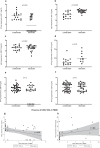Kaposi's sarcoma-associated herpesvirus T cell responses in HIV seronegative individuals from rural Uganda
- PMID: 34916520
- PMCID: PMC8677732
- DOI: 10.1038/s41467-021-27623-8
Kaposi's sarcoma-associated herpesvirus T cell responses in HIV seronegative individuals from rural Uganda
Abstract
T cell responses to Kaposi's sarcoma-associated herpesvirus (KSHV) are likely essential in the control of KSHV infection and protection from associated disease, but remain poorly characterised. KSHV prevalence in rural Uganda is high at >90%. Here we investigate IFN- γ T cell responses to the KSHV proteome in HIV-negative individuals from a rural Ugandan population. We use an ex-vivo IFN- γ ELISpot assay with overlapping peptide pools spanning 83 KSHV open reading frames (ORF) on peripheral blood mononuclear cells (PBMC) from 116 individuals. KSHV-specific T cell IFN- γ responses are of low intensity and heterogeneous, with no evidence of immune dominance; by contrast, IFN- γ responses to Epstein-Barr virus, Cytomegalovirus and influenza peptides are frequent and intense. Individuals with KSHV DNA in PBMC have higher IFN- γ responses to ORF73 (p = 0.02) and lower responses to K8.1 (p = 0.004) when compared with those without KSHV DNA. In summary, we demonstrate low intensity, heterogeneous T cell responses to KSHV in immune-competent individuals.
© 2021. The Author(s).
Conflict of interest statement
The authors declare no competing interests.
Figures






References
-
- Hislop AD, Sabbah S. CD8+ T cell immunity to Epstein-Barr virus and Kaposi’s sarcoma-associated herpes virus. Semin Cancer Biol. 2008;18:416–422. - PubMed
-
- Lagos, D. & Boshoff, C. Immunobiology and host response to KSHV infection. In: Human Herpesviruses: Biology, Therapy, and Immunoprophylaxis (eds Arvin, A. et al.) (Cambridge University Press Copyright © Cambridge University Press, Cambridge, 2007). - PubMed
-
- Barozzi P, et al. Changes in the immune responses against human herpesvirus-8 in the disease course of posttransplant Kaposi sarcoma. Transplantation. 2008;86:738–744. - PubMed
Publication types
MeSH terms
Substances
Grants and funding
LinkOut - more resources
Full Text Sources
Research Materials

